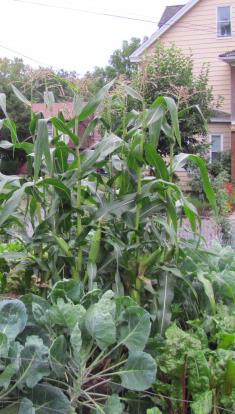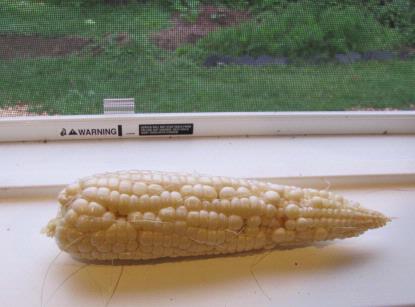Until last year I avoided growing corn. I can buy it at nearly any farm for next to nothing and even though it’s not quite as fresh as garden corn, it tastes better than the week old stuff (if you’re lucky) at the big grocery stores. But last year I planted two solid blocks of corn. Each had at least five foot sides. It took a long time, but the corn I got tasted so great that the squirrels ate half of it. I suppose that’s not a particularly good point as I just watched a squirrel rooting around in a garbage can looking for cafeteria scraps.
So this year I planted my corn in a more defensible area within my semi-militarized fenced in garden. The military in this case consists of the cats that perch on the fence posts and deter varmints. I also tried planting a little corn every few weeks, but in smaller blocks. I thought maybe I’d get a steady stream and thus might get enough corn to eat for several weeks.
The corn has done remarkably well, growing tall and a dark green – corn needs lots of nitrogen to make all the green chloroplasts, so I fertilized with plenty of compost and dried blood. In early August I could see the tassels and silks emerging and knew that things were on the right path.

The tassels contain the cells that eventually become pollen: microspore mother cells. Corn, like most grasses is wind pollinated so it makes outrageous quantities of pollen that blow in the wind to land upon the waiting silks. The silk forms corn’s showy female naughty bits. When a pollen grain lands on that silk it grows a tube the whole length of the silk until it find the waiting immature kernel (the ovule). By the time it gets there it bursts inside the ovule depositing two sperm cells, one in the egg and one inside the rest of the ovule. It then usually asks for a sandwich and falls asleep.
By the way, I’d like to make a pitch for using corn as an example of cis-sexuality for our children. Both birds and bees lay eggs and bees are almost all female. That confuses the little buggers.
This year not enough pollen made it to all my corn kernels because I didn’t plant in large enough blocks. This gives cobs that look like the one pictured. In this one many of the other kernels made up for the unfertilized kernels by getting really big. It still tastes great.
I picked the one pictured less than five minutes before eating it and I didn’t need to cook it at all: I brushed off the silks and tore in. The ears were still complaining that the pollen never calls anymore.



